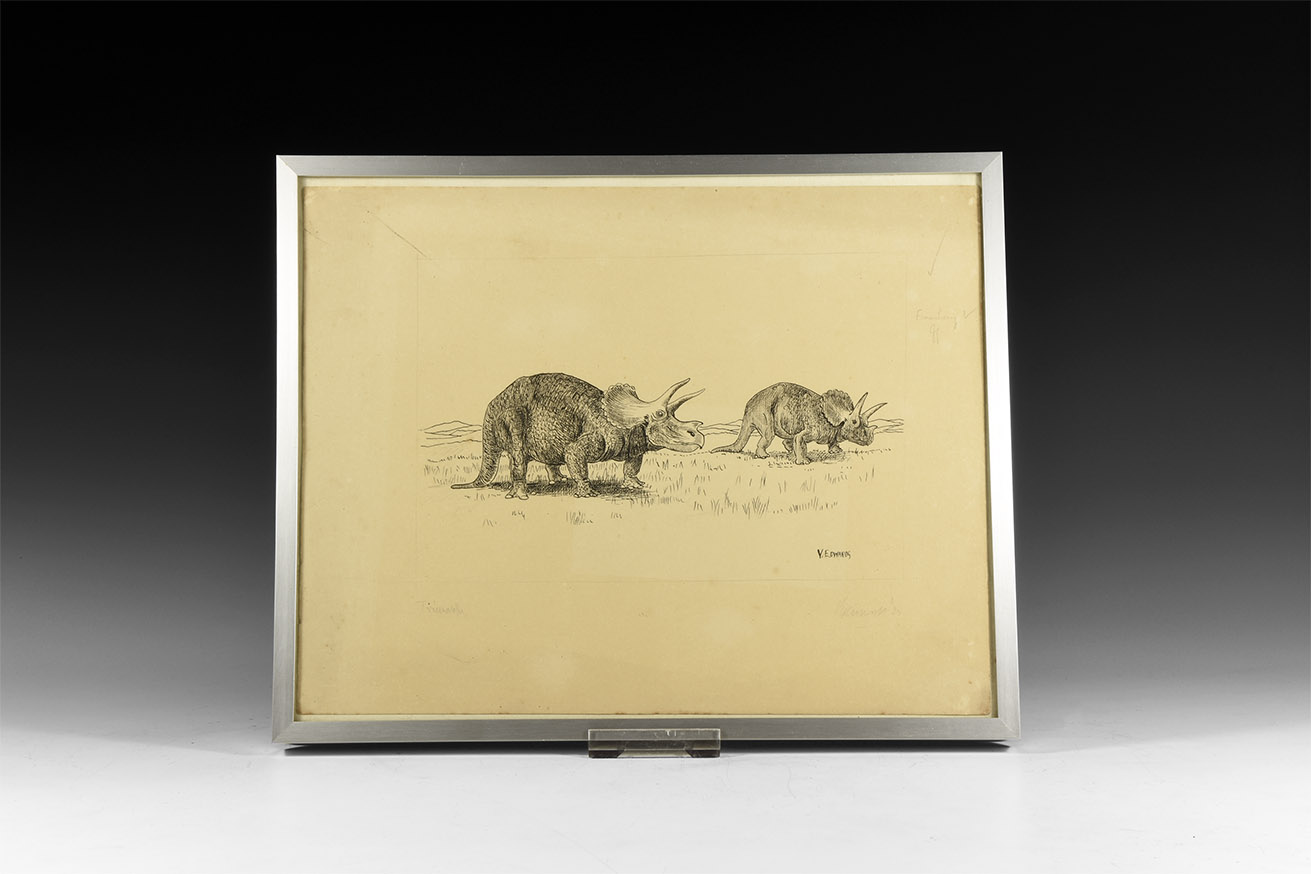NATURAL HISTORY - TRICERATOPS DINOSAUR MODEL WITH SKETCHES BY VERNON EDWARDS Circa 1930 A model of Triceratops on a textured rectangular wooden base directly carved by Vernon Edwards, possibly the model used for plate XIX in Swinton's book 'The Dinosaurs' (1934); a display card with text by WE. Swinton B.Sc., F.Z.S.; two preparatory sketches with skeletal details and production notes; a monochrome photograph of three examples of the model in a natural setting; pamphlet A Catalogue of Plaster Cast Models of Extinct Animals listing the model on page 6; this is probably the original master of this model from which rubber moulds were taken for the production of copies. 495 grams total, model: 19.5cm (7 3/4"). [6, No Reserve] Condition Fair condition; horns damaged, base split. Provenance From the historic collection of Gregory, Bottley & Lloyd; acquired by Percy Bottley of Gregory, Bottley & Co. in the 1930s; formerly from a historic natural history art collection, the artistic work of Palaeontologist, Commander Vernon Edwards. Literature See Swinton, Dr William Elgin, Monsters of Primeval Days, London, 1931; see also, same author, The Dinosaurs - A Short History of a Great Group of Extinct Reptiles, London, 1934, wherein many of the drawings, models and dioramas created by Edwards are published, described and illustrated (the author at the Natural History Museum, London, 1924-1961, later Director of Life Sciences, Royal Ontario Museum, Canada, died 1994). Footnotes Vernon Edwards is credited as being one of the most talented and influential dinosaur model makers of the 20th century. His work has appeared in museums and galleries around the world; it was a major influence on movie producers and early special effects creators, particularly when films such as The Lost World and King Kong began to showcase dinosaurs as part of the increasingly popular ‘monster movies’ of the 1920's and 30's. Edwards was born in 1891 into a naval family and attended Weymouth College. In 1914 he joined the navy and served throughout World War One; after the war he found it difficult to adjust to civilian life and, among other professions, tried his hand at farming. His greatest passion was model making, being self taught in art and anatomy, and it was whilst staying with family in Sussex in the early 1920's that he met Dr F.A. Bather, Keeper of Geology at the British Museum. Dr. Bather was impressed by the detailed and accurate models that Edwards was producing and asked him to produce a series of prehistoric models for the British Museum (Natural History), now known as the Natural History Museum. Vernon Edwards was given access to the museum's collections and scientific monographs, so the models he produced were up to
NATURAL HISTORY - TRICERATOPS DINOSAUR MODEL WITH SKETCHES BY VERNON EDWARDS Circa 1930 A model of Triceratops on a textured rectangular wooden base directly carved by Vernon Edwards, possibly the model used for plate XIX in Swinton's book 'The Dinosaurs' (1934); a display card with text by WE. Swinton B.Sc., F.Z.S.; two preparatory sketches with skeletal details and production notes; a monochrome photograph of three examples of the model in a natural setting; pamphlet A Catalogue of Plaster Cast Models of Extinct Animals listing the model on page 6; this is probably the original master of this model from which rubber moulds were taken for the production of copies. 495 grams total, model: 19.5cm (7 3/4"). [6, No Reserve] Condition Fair condition; horns damaged, base split. Provenance From the historic collection of Gregory, Bottley & Lloyd; acquired by Percy Bottley of Gregory, Bottley & Co. in the 1930s; formerly from a historic natural history art collection, the artistic work of Palaeontologist, Commander Vernon Edwards. Literature See Swinton, Dr William Elgin, Monsters of Primeval Days, London, 1931; see also, same author, The Dinosaurs - A Short History of a Great Group of Extinct Reptiles, London, 1934, wherein many of the drawings, models and dioramas created by Edwards are published, described and illustrated (the author at the Natural History Museum, London, 1924-1961, later Director of Life Sciences, Royal Ontario Museum, Canada, died 1994). Footnotes Vernon Edwards is credited as being one of the most talented and influential dinosaur model makers of the 20th century. His work has appeared in museums and galleries around the world; it was a major influence on movie producers and early special effects creators, particularly when films such as The Lost World and King Kong began to showcase dinosaurs as part of the increasingly popular ‘monster movies’ of the 1920's and 30's. Edwards was born in 1891 into a naval family and attended Weymouth College. In 1914 he joined the navy and served throughout World War One; after the war he found it difficult to adjust to civilian life and, among other professions, tried his hand at farming. His greatest passion was model making, being self taught in art and anatomy, and it was whilst staying with family in Sussex in the early 1920's that he met Dr F.A. Bather, Keeper of Geology at the British Museum. Dr. Bather was impressed by the detailed and accurate models that Edwards was producing and asked him to produce a series of prehistoric models for the British Museum (Natural History), now known as the Natural History Museum. Vernon Edwards was given access to the museum's collections and scientific monographs, so the models he produced were up to















Testen Sie LotSearch und seine Premium-Features 7 Tage - ohne Kosten!
Lassen Sie sich automatisch über neue Objekte in kommenden Auktionen benachrichtigen.
Suchauftrag anlegen